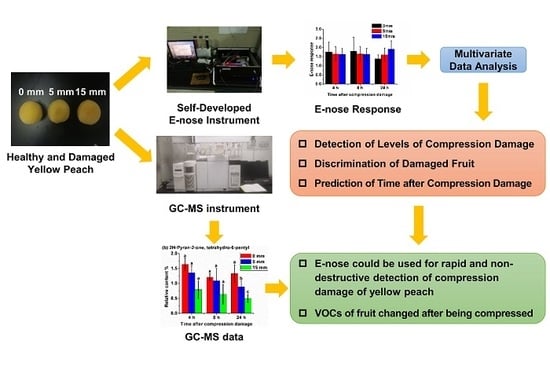Rapid and Non-Destructive Detection of Compression Damage of Yellow Peach Using an Electronic Nose and Chemometrics
Abstract
:1. Introduction
2. Materials and Methods
2.1. Sample Preparation
2.2. E-Nose Instrument and Data Acquisition
2.3. Multivariate Data Analysis
2.4. GC–MS Non-Destructive Measurement
3. Results
3.1. E-Nose Response of Peach Fruit
3.2. Detection of Levels of Compression Damage
3.3. Discrimination of Damaged Fruit
3.4. Prediction of Time after Compression Damage
3.5. GC–MS Analysis
4. Discussion
5. Conclusions
Supplementary Materials
Author Contributions
Funding
Conflicts of Interest
References
- Byrne, D.H.; Raseira, M.B.; Bassi, D.; Piagnani, M.C.; Gasic, K.; Reighard, G.L.; Moreno, M.A.; Pérez, S. Peach. In Fruit Breeding; Badenes, M.L., Byrne, D.H., Eds.; Springer: Boston, MA, USA, 2012; pp. 505–569. [Google Scholar]
- Gil, M.I.; Tomás-Barberán, F.A.; Hess-Pierce, B.; Kader, A.A. Antioxidant capacities, phenolic compounds, carotenoids, and vitamin C contents of nectarine, peach, and plum cultivars from California. J. Agric. Food Chem. 2002, 50, 4976–4982. [Google Scholar] [CrossRef] [PubMed]
- Vizzotto, M.; Cisneros-Zevallos, L.; Byrne, D.H.; Ramming, D.W.; Okie, W. Large variation found in the phytochemical and antioxidant activity of peach and plum germplasm. J. Am. Soc. Hort. Sci. 2007, 132, 334–340. [Google Scholar] [CrossRef] [Green Version]
- Brandi, F.; Bar, E.; Mourgues, F.; Horváth, G.; Turcsi, E.; Giuliano, G.; Liverani, A.; Tartarini, S.; Lewinsohn, E.; Rosati, C. Study of ‘Redhaven’ peach and its white-fleshed mutant suggests a key role of CCD4 carotenoid dioxygenase in carotenoid and norisoprenoid volatile metabolism. BMC Plant Biol. 2011, 11, 24. [Google Scholar] [CrossRef] [PubMed] [Green Version]
- Yu, Y.-B.; Yang, S.F. Biosynthesis of wound ethylene. Plant Physiol. 1980, 66, 281–285. [Google Scholar] [CrossRef] [PubMed] [Green Version]
- Li, J.; Yan, J.; Cao, J.; Zhao, Y.; Jiang, W. Preventing the wound-induced deterioration of Yali pears by chitosan coating treatments. Food Sci. Technol. Int. 2012, 18, 123–128. [Google Scholar] [CrossRef]
- Polashock, J.J.; Saftner, R.A.; Kramer, M. Postharvest highbush blueberry fruit antimicrobial volatile profiles in relation to anthracnose fruit rot resistance. J. Am. Soc. Hort. Sci. 2007, 132, 859–868. [Google Scholar] [CrossRef] [Green Version]
- Wu, D.; Sun, D.-W. Advanced applications of hyperspectral imaging technology for food quality and safety analysis and assessment: A review—Part I: Fundamentals. Innov. Food Sci. Emerg. Technol. 2013, 19, 1–14. [Google Scholar] [CrossRef]
- Wu, D.; Sun, D.-W. Advanced applications of hyperspectral imaging technology for food quality and safety analysis and assessment: A review—Part II: Applications. Innov. Food Sci. Emerg. Technol. 2013, 19, 15–28. [Google Scholar] [CrossRef]
- Baietto, M.; Wilson, A.D. Electronic-nose applications for fruit identification, ripeness and quality grading. Sensors 2015, 15, 899–931. [Google Scholar] [CrossRef]
- Sanaeifar, A.; Mohtasebi, S.S.; Ghasemi-Varnamkhasti, M.; Ahmadi, H. Application of MOS based electronic nose for the prediction of banana quality properties. Measurement 2016, 82, 105–114. [Google Scholar] [CrossRef]
- Horvat, R.; Chapman, G., Jr.; Robertson, J.; Meredith, F.; Scorza, R.; Callahan, A.; Morgens, P. Comparison of the volatile compounds from several commercial peach cultivars. J. Agric. Food Chem. 1990, 38, 234–237. [Google Scholar] [CrossRef]
- Chen, J.L.; Wu, J.H.; Wang, Q.; Deng, H.; Hu, X.S. Changes in the volatile compounds and chemical and physical properties of Kuerle fragrant pear (Pyrus serotina Reld) during storage. J. Agric. Food Chem. 2006, 54, 8842–8847. [Google Scholar] [CrossRef] [PubMed]
- Hui, G.; Wu, Y.; Ye, D.; Ding, W.; Zhu, L.; Wang, L. Study of peach freshness predictive method based on electronic nose. Food Control 2012, 28, 25–32. [Google Scholar]
- Besada, C.; Salvador, A.; Sdiri, S.; Gil, R.; Granell, A. A combination of physiological and chemometrics analyses reveals the main associations between quality and ripening traits and volatiles in two loquat cultivars. Metabolomics 2013, 9, 324–336. [Google Scholar] [CrossRef]
- Mayuoni-Kirshinbaum, L.; Daus, A.; Porat, R. Changes in sensory quality and aroma volatile composition during prolonged storage of ‘Wonderful’pomegranate fruit. Int. J. Food Sci. Technol. 2013, 48, 1569–1578. [Google Scholar] [CrossRef]
- Yi, J.; Kebede, B.T.; Grauwet, T.; Van Loey, A.; Hu, X.; Hendrickx, M. A multivariate approach into physicochemical, biochemical and aromatic quality changes of purée based on Hayward kiwifruit during the final phase of ripening. Postharvest. Biol. Technol. 2016, 117, 206–216. [Google Scholar] [CrossRef]
- Migliori, C.A.; Salvati, L.; Di Cesare, L.F.; Scalzo, R.L.; Parisi, M. Effects of preharvest applications of natural antimicrobial products on tomato fruit decay and quality during long-term storage. Sci. Hortic. 2017, 222, 193–202. [Google Scholar] [CrossRef]
- Hines, E.L.; Llobet, E.; Gardner, J.W. Electronic noses: A review of signal processing techniques. IEE Proc. Circuits Devices Syst. 1999, 146, 297–310. [Google Scholar] [CrossRef]
- Srivastava, S.; Sadistap, S. Data processing approaches and strategies for non-destructive fruits quality inspection and authentication: A review. J. Food Meas. Charact. 2018, 12, 2758–2794. [Google Scholar] [CrossRef]
- Rusinek, R.; Gancarz, M.; Krekora, M.; Nawrocka, A. A novel method for generation of a fingerprint using electronic nose on the example of rapeseed spoilage. J. Food Sci. 2019, 84, 51–58. [Google Scholar] [CrossRef] [Green Version]
- Rusinek, R.; Siger, A.; Gawrysiak-Witulska, M.; Rokosik, E.; Malaga-Toboła, U.; Gancarz, M. Application of an electronic nose for determination of pre-pressing treatment of rapeseed based on the analysis of volatile compounds contained in pressed oil. Int. J. Food Sci. Technol. 2020. [Google Scholar] [CrossRef]
- Li, C.; Krewer, G.W.; Ji, P.; Scherm, H.; Kays, S.J. Gas sensor array for blueberry fruit disease detection and classification. Postharvest. Biol. Technol. 2010, 55, 144–149. [Google Scholar] [CrossRef]
- Gruber, J.; Nascimento, H.M.; Yamauchi, E.Y.; Li, R.W.; Esteves, C.H.; Rehder, G.P.; Gaylarde, C.C.; Shirakawa, M.A. A conductive polymer based electronic nose for early detection of Penicillium digitatum in post-harvest oranges. Mater. Sci. Eng. C 2013, 33, 2766–2769. [Google Scholar] [CrossRef] [PubMed]
- Wang, H.; Hu, Z.; Long, F.; Guo, C.; Yuan, Y.; Yue, T. Early detection of Zygosaccharomyces Rouxii—spawned spoilage in apple juice by electronic nose combined with chemometrics. Int. J. Food Microbiol. 2016, 217, 68–78. [Google Scholar] [CrossRef] [PubMed]
- Zhang, W.; Pan, L.; Zhao, X.; Tu, K. A study on soluble solids content assessment using electronic nose: Persimmon fruit picked on different dates. Int. J. Food Prop. 2016, 19, 53–62. [Google Scholar] [CrossRef] [Green Version]
- Srivastava, S.; Sadisatp, S. Development of a low cost optimized handheld embedded odor sensing system (HE-Nose) to assess ripeness of oranges. J. Food Meas. Charact. 2016, 10, 1–15. [Google Scholar] [CrossRef]
- Hui, G.; Wu, Y.; Ye, D.; Ding, W. Fuji apple storage time predictive method using electronic nose. Food Anal. Meth. 2013, 6, 82–88. [Google Scholar]
- Di Natale, C.; Macagnano, A.; Martinelli, E.; Paolesse, R.; Proietti, E.; D’Amico, A. The evaluation of quality of post-harvest oranges and apples by means of an electronic nose. Sens. Actuators B Chem. 2001, 78, 26–31. [Google Scholar] [CrossRef]
- Young, R.C.; Buttner, W.J.; Linnell, B.R.; Ramesham, R. Electronic nose for space program applications. Sens. Actuators B Chem. 2003, 93, 7–16. [Google Scholar] [CrossRef]
- Qian, T.; Xu, R.; Kwan, C.; Linnell, B.; Young, R. Toxic vapor classification and concentration estimation for space shuttle and international space station. In Proceedings of the Advances in Neural Networks -ISNN 2004, International Symposium on Neural Networks, Part I, Dalian, China, 19–21 August 2004; pp. 543–551. [Google Scholar]
- Ryan, M.A.; Zhou, H.; Buehler, M.G.; Manatt, K.S.; Mowrey, V.S.; Jackson, S.P.; Kisor, A.K.; Shevade, A.V.; Homer, M.L. Monitoring space shuttle air quality using the jet propulsion laboratory electronic nose. IEEE Sens. J. 2004, 4, 337–347. [Google Scholar] [CrossRef]
- Li, W.; Leung, H.; Kwan, C.; Linnell, B.R. E-nose vapor identification based on dempster-shafer fusion of multiple classifiers. IEEE Trans. Instrum. Meas. 2008, 57, 2273–2282. [Google Scholar] [CrossRef]
- Roussel, S.; Forsberg, G.; Steinmetz, V.; Grenier, P.; Bellon-Maurel, V. Optimisation of electronic nose measurements. Part I: Methodology of output feature selection. J. Food Eng. 1998, 37, 207–222. [Google Scholar] [CrossRef]
- Carmel, L.; Levy, S.; Lancet, D.; Harel, D. A feature extraction method for chemical sensors in electronic noses. Sens. Actuators B Chem. 2003, 93, 67–76. [Google Scholar] [CrossRef]
- Wilson, D.M.; DeWeerth, S.P. Odor discrimination using steady-state and transient characteristics of tin-oxide sensors. Sens. Actuators B Chem. 1995, 28, 123–128. [Google Scholar] [CrossRef]
- Kish, L.B.; Vajtai, R.; Granqvist, C.G. Extracting information from noise spectra of chemical sensors: Single sensor electronic noses and tongues. Sens. Actuators B Chem. 2000, 71, 55–59. [Google Scholar] [CrossRef]
- Kish, L.B.; Smulko, J.; Heszler, P.; Granqvist, C.G. On the sensitivity, selectivity, sensory information and optimal size of resistive chemical sensors. Nanotechnol. Percept. 2007, 3, 43–52. [Google Scholar] [CrossRef]
- Schmera, G.; Kwan, C.; Ajayan, P.; Vajtai, R.; Kish, L.B. Fluctuation-enhanced sensing: Status and perspectives. IEEE Sens. J. 2008, 8, 714–719. [Google Scholar] [CrossRef]
- Ayhan, B.; Kwan, C.; Zhou, J.; Kish, L.B.; Benkstein, K.D.; Rogers, P.H.; Semancik, S. Fluctuation enhanced sensing (FES) with a nanostructured, semiconducting metal oxide film for gas detection and classification. Sens. Actuators B Chem. 2013, 188, 651–660. [Google Scholar] [CrossRef]
- Kwan, C.; Schmera, G.; Smulko, J.M.; Kish, L.B.; Heszler, P.; Granqvist, C.-G. Advanced agent identification with fluctuation-enhanced sensing. IEEE Sens. J. 2008, 8, 706–713. [Google Scholar] [CrossRef]
- Chen, J.; Gu, J.; Zhang, R.; Mao, Y.; Tian, S. Freshness evaluation of three kinds of meats based on the electronic nose. Sensors 2019, 19, 605. [Google Scholar] [CrossRef] [Green Version]
- Chen, X.; Xu, Y.; Meng, L.; Chen, X.; Yuan, L.; Cai, Q.; Shi, W.; Huang, G. Non-parametric partial least squares–discriminant analysis model based on sum of ranking difference algorithm for tea grade identification using electronic tongue data identify tea grade using e-tongue data. Sens. Actuators B Chem. 2020, 311, 127924. [Google Scholar] [CrossRef]
- Li, J.Z.; Liu, H.X.; Yao, X.J.; Liu, M.C.; Hu, Z.D.; Fan, B.T. Structure-activity relationship study of oxindole-based inhibitors of cyclin-dependent kinases based on least-squares support vector machines. Anal. Chim. Acta 2007, 581, 333–342. [Google Scholar] [CrossRef] [PubMed]
- Araujo, M.C.U.; Saldanha, T.C.B.; Galvao, R.K.H.; Yoneyama, T.; Chame, H.C.; Visani, V. The successive projections algorithm for variable selection in spectroscopic multicomponent analysis. Chemom. Intell. Lab. Syst. 2001, 57, 65–73. [Google Scholar] [CrossRef]
- Liu, K.; Chen, X.; Li, L.; Chen, H.; Ruan, X.; Liu, W. A consensus successive projections algorithm—multiple linear regression method for analyzing near infrared spectra. Anal. Chim. Acta 2015, 858, 16–23. [Google Scholar] [CrossRef]
- Centner, V.; Massart, D.L.; deNoord, O.E.; deJong, S.; Vandeginste, B.M.; Sterna, C. Elimination of uninformative variables for multivariate calibration. Anal. Chem. 1996, 68, 3851–3858. [Google Scholar] [CrossRef]
- Galvao, R.K.H.; Araujo, M.C.U.; Jose, G.E.; Pontes, M.J.C.; Silva, E.C.; Saldanha, T.C.B. A method for calibration and validation subset partitioning. Talanta 2005, 67, 736–740. [Google Scholar] [CrossRef]
- Esteve, A.L.; Armstrong, P.R.; Romagosa, C.I.; Hurburgh, C.R. Measurement of single soybean seed attributes by near-infrared technologies. A comparative study. J. Agric. Food Chem. 2012, 60, 8314–8322. [Google Scholar] [CrossRef]
- Wang, B.; Jiang, H.; Bi, Y.; He, X.; Wang, Y.; Li, Y.; Zheng, X.; Prusky, D. Preharvest multiple sprays with sodium nitroprusside promote wound healing of harvested muskmelons by activation of phenylpropanoid metabolism. Postharvest. Biol. Technol. 2019, 158, 110988. [Google Scholar] [CrossRef]
- Shao, X.; Tu, K.; Tu, S.; Su, J.; Zhao, Y. Effects of heat treatment on wound healing in gala and Red fuji apple fruits. J. Agric. Food Chem. 2010, 58, 4303–4309. [Google Scholar] [CrossRef]
- Song, J.; Bi, J.; Chen, Q.; Wu, X.; Lyu, Y.; Meng, X. Assessment of sugar content, fatty acids, free amino acids, and volatile profiles in jujube fruits at different ripening stages. Food Chem. 2019, 270, 344–352. [Google Scholar] [CrossRef]
- Lu, X.; Meng, G.; Jin, W.; Gao, H. Effects of 1-MCP in combination with Ca application on aroma volatiles production and softening of ‘Fuji’apple fruit. Sci. Hortic. 2018, 229, 91–98. [Google Scholar] [CrossRef]
- Echeverría, G.; Correa, E.; Ruiz-Altisent, M.; Graell, J.; Puy, J.; López, L. Characterization of Fuji apples from different harvest dates and storage conditions from measurements of volatiles by gas chromatography and electronic nose. J. Agric. Food Chem. 2004, 52, 3069–3076. [Google Scholar] [CrossRef] [PubMed]
- Pan, L.; Zhang, W.; Zhu, N.; Mao, S.; Tu, K. Early detection and classification of pathogenic fungal disease in post-harvest strawberry fruit by electronic nose and gas chromatography–mass spectrometry. Food Res. Int. 2014, 62, 162–168. [Google Scholar] [CrossRef]
- Wen, T.; Zheng, L.; Dong, S.; Gong, Z.; Sang, M.; Long, X.; Luo, M.; Peng, H. Rapid detection and classification of citrus fruits infestation by Bactrocera dorsalis (Hendel) based on electronic nose. Postharvest. Biol. Technol. 2019, 147, 156–165. [Google Scholar] [CrossRef]
- Liu, Q.; Zhao, N.; Zhou, D.; Sun, Y.; Sun, K.; Pan, L.; Tu, K. Discrimination and growth tracking of fungi contamination in peaches using electronic nose. Food Chem. 2018, 262, 226–234. [Google Scholar] [CrossRef]
- Li, J.; Zheng, F.; Jiang, J.; Lin, H.; Hui, G. Chinese bayberry (Myrica rubra Sieb. et Zucc.) quality determination based on an electronic nose and non-linear dynamic model. Anal. Methods 2015, 7, 9928–9939. [Google Scholar] [CrossRef]
- Wei, X.; Zhang, Y.; Wu, D.; Wei, Z.; Chen, K. Rapid and non-destructive detection of decay in peach fruit at the cold environment using a self-developed handheld electronic-nose system. Food Anal. Meth. 2018, 11, 2290–3004. [Google Scholar] [CrossRef]
- Demir, N.; Ferraz, A.C.O.; Sargent, S.A.; Balaban, M.O. Classification of impacted blueberries during storage using an electronic nose. J. Sci. Food Agric. 2011, 91, 1722–1727. [Google Scholar] [CrossRef]
- Ren, Y.; Ramaswamy, H.S.; Li, Y.; Yuan, C.; Ren, X. Classification of impact injury of apples using electronic nose coupled with multivariate statistical analyses. J. Food Process Eng. 2018, 41, e12698. [Google Scholar] [CrossRef]
- Chen, H.-Z.; Zhang, M.; Guo, Z. Discrimination of fresh-cut broccoli freshness by volatiles using electronic nose and gas chromatography-mass spectrometry. Postharvest. Biol. Technol. 2019, 148, 168–175. [Google Scholar] [CrossRef]
- Huang, L.; Liu, H.; Zhang, B.; Wu, D. Application of electronic nose with multivariate analysis and sensor selection for botanical origin identification and quality determination of honey. Food Bioprocess Technol. 2015, 8, 359–370. [Google Scholar] [CrossRef]

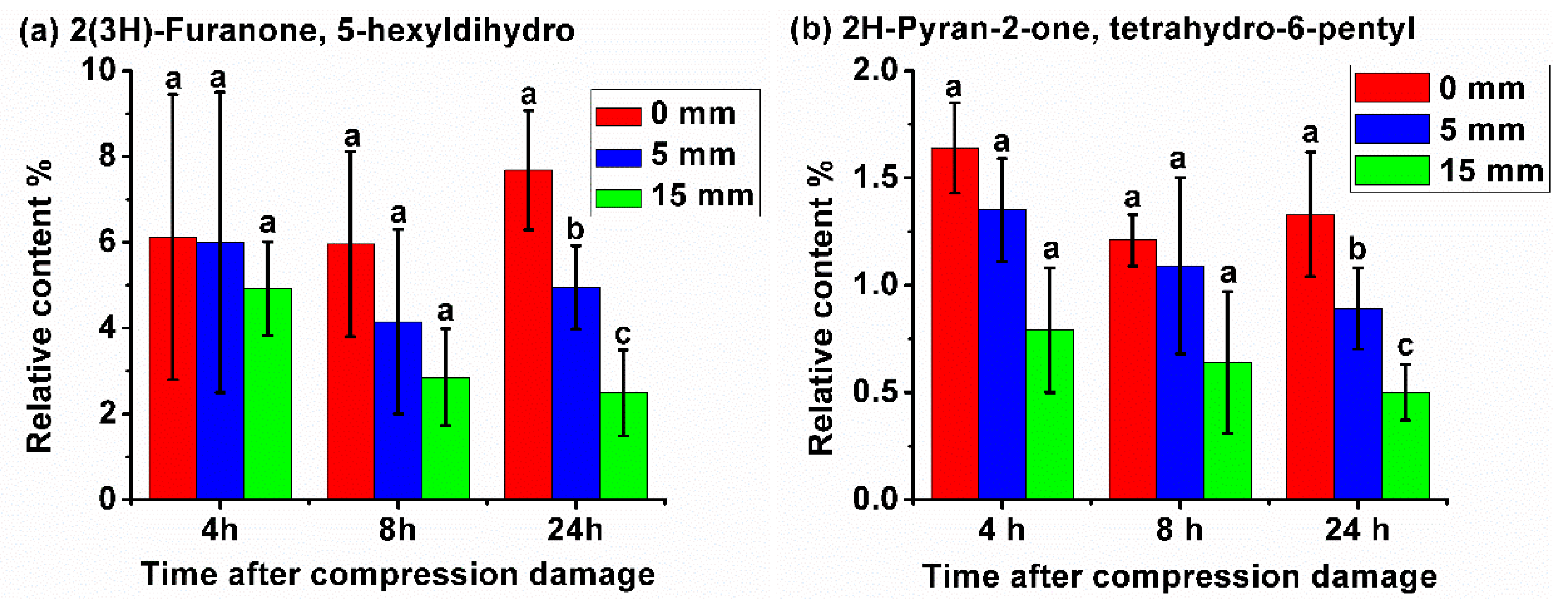
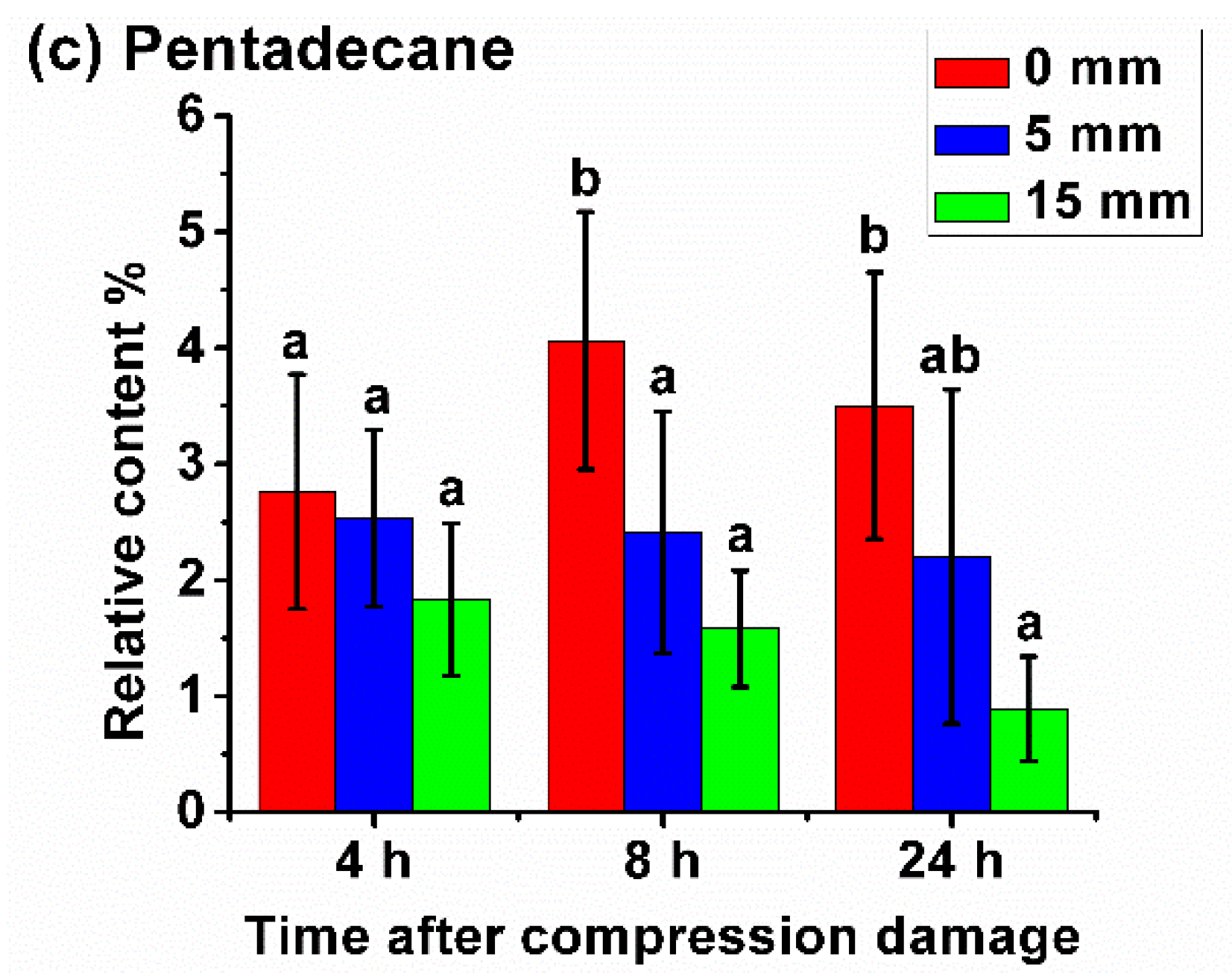
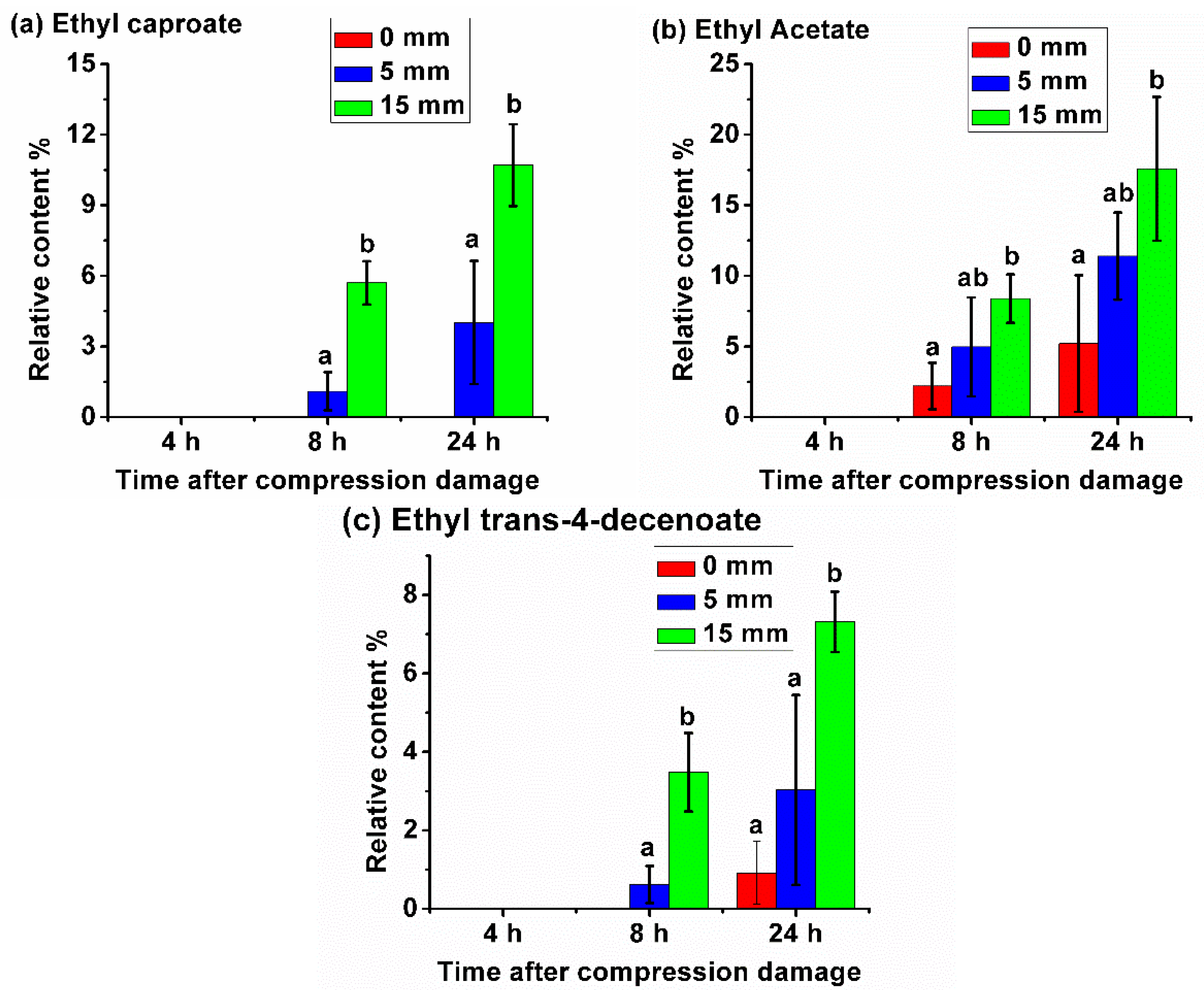
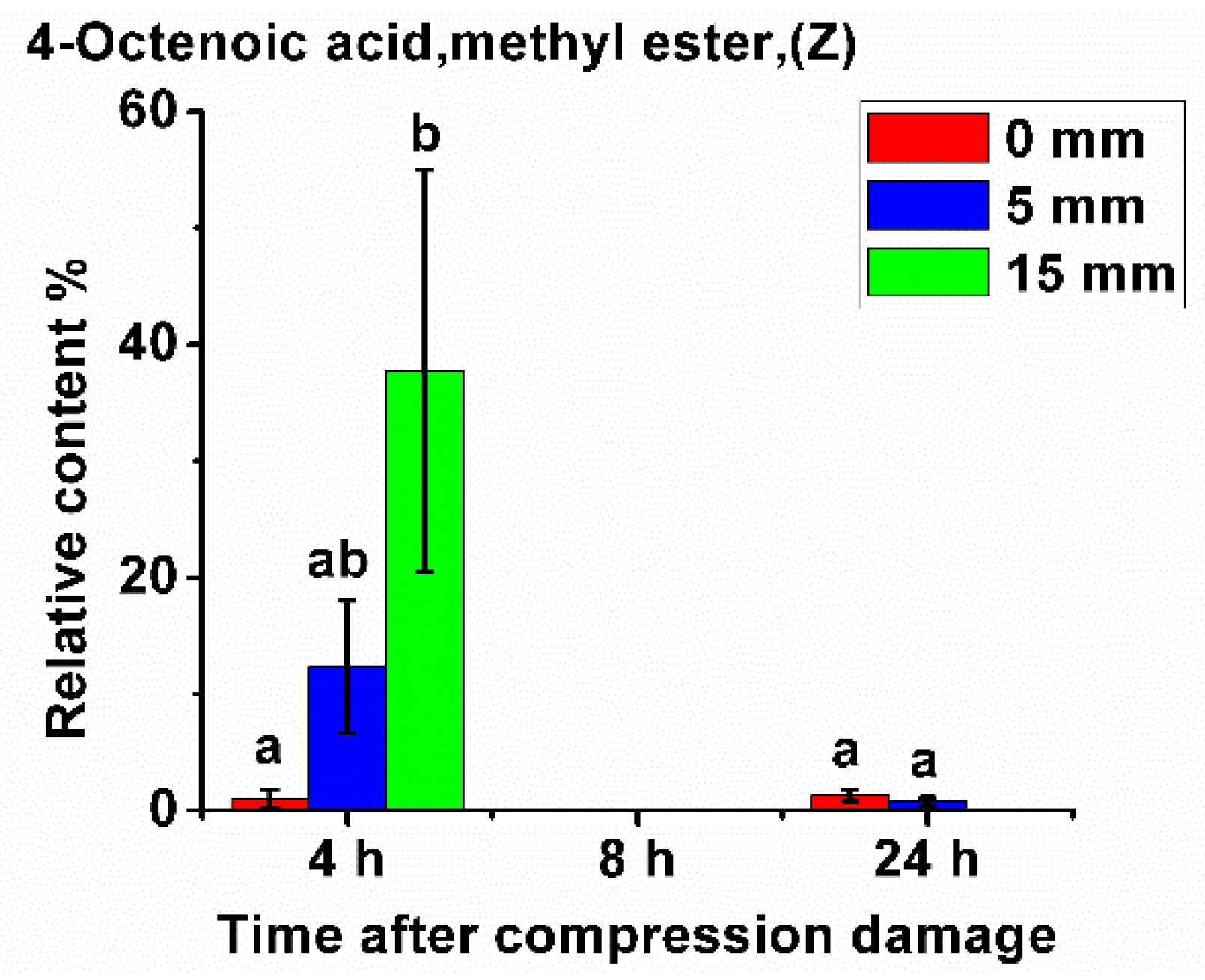
| Sensor Number | Sensor Model | Sensitive Substances |
|---|---|---|
| S1 | TGS 826 | Ammonia, amines |
| S2 | MQ-136 | Hydrogen sulfide, sulfide |
| S3 | TGS 821 | Hydrogen |
| S4 | TGS 822 | Alcohol, organic solvents |
| S5 | MQ-138 | Toluene, acetone, ethanol, formaldehyde, hydrogen, and other organic vapors |
| S6 | MQ-4 | Methane, biogas, natural gas |
| S7 | TGS 813 | Methane, propane, isobutane, natural gas, liquefied gas |
| S8 | TGS 2602 | Cigarette smoke, cooking odor, VOC, ammonia, hydrogen sulfide, alcohol |
| S9 | MQ-5 | Butane, propane, methane, liquefied gas, natural gas, gas |
| S10 | TGS 2610 | Liquefied petroleum gas, combustible gas, propane, butane |
| S11 | MQ-2 | Propane, smoke, combustible gas |
| S12 | TGS 2620 | Carbon monoxide, ethanol, organic solvents, other volatile gases |
| S13 | TGS 2600 | Smoke, cooking odor, hydrogen, carbon monoxide, air pollutants |
| S14 | TGS 2611 | Methane, natural gas |
| Sensor Number | 0 mm | 5 mm | 15 mm | ||||
|---|---|---|---|---|---|---|---|
| Mean Value | Standard Deviation | Mean Value | Standard Deviation | Mean Value | Standard Deviation | ||
| 1 | 4 h | 1.389 | 1.125 | 1.240 | 0.697 | 1.293 | 0.686 |
| 8 h | 2.122 | 1.308 | 1.641 | 0.834 | 1.293 | 0.686 | |
| 24 h | 1.303 | 0.495 | 1.544 | 0.971 | 2.539 | 1.083 | |
| 2 | 4 h | 1.410 | 1.288 | 1.462 | 0.991 | 1.310 | 0.949 |
| 8 h | 2.040 | 1.634 | 1.332 | 1.004 | 1.310 | 0.949 | |
| 24 h | 1.235 | 0.603 | 1.613 | 1.273 | 2.299 | 1.447 | |
| 3 | 4 h | 0.126 | 0.078 | 0.085 | 0.069 | 0.101 | 0.070 |
| 8 h | 0.088 | 0.056 | 0.108 | 0.081 | 0.101 | 0.070 | |
| 24 h | 0.106 | 0.076 | 0.106 | 0.091 | 0.111 | 0.083 | |
| 4 | 4 h | 0.868 | 0.423 | 0.712 | 0.294 | 0.720 | 0.271 |
| 8 h | 0.803 | 0.277 | 0.739 | 0.418 | 0.720 | 0.271 | |
| 24 h | 1.059 | 0.952 | 0.892 | 0.367 | 1.223 | 0.504 | |
| 5 | 4 h | 0.207 | 0.114 | 0.257 | 0.178 | 0.248 | 0.151 |
| 8 h | 0.290 | 0.238 | 0.265 | 0.188 | 0.248 | 0.151 | |
| 24 h | 0.229 | 0.127 | 0.304 | 0.196 | 0.462 | 0.243 | |
| 6 | 4 h | 1.752 | 0.536 | 1.650 | 0.377 | 1.628 | 0.313 |
| 8 h | 1.804 | 0.748 | 1.641 | 0.423 | 1.628 | 0.313 | |
| 24 h | 1.388 | 0.206 | 1.607 | 0.359 | 1.897 | 0.467 | |
| 7 | 4 h | 0.576 | 0.315 | 0.474 | 0.082 | 0.504 | 0.078 |
| 8 h | 0.564 | 0.394 | 0.521 | 0.167 | 0.504 | 0.078 | |
| 24 h | 0.612 | 0.564 | 0.599 | 0.426 | 0.713 | 0.247 | |
| 8 | 4 h | 0.749 | 0.728 | 0.570 | 0.403 | 0.885 | 0.659 |
| 8 h | 1.635 | 1.418 | 1.108 | 0.540 | 0.885 | 0.659 | |
| 24 h | 1.079 | 1.002 | 1.116 | 0.960 | 2.366 | 1.503 | |
| 9 | 4 h | 1.577 | 0.977 | 1.493 | 0.649 | 1.362 | 0.560 |
| 8 h | 1.844 | 1.188 | 1.390 | 0.629 | 1.362 | 0.560 | |
| 24 h | 1.199 | 0.283 | 1.418 | 0.614 | 1.793 | 0.751 | |
| 10 | 4 h | 0.939 | 0.294 | 0.836 | 0.190 | 0.855 | 0.201 |
| 8 h | 0.937 | 0.325 | 0.968 | 0.360 | 0.855 | 0.201 | |
| 24 h | 1.040 | 0.864 | 0.937 | 0.231 | 1.240 | 0.331 | |
| 11 | 4 h | 1.028 | 0.876 | 0.949 | 0.506 | 0.921 | 0.509 |
| 8 h | 1.299 | 0.922 | 0.978 | 0.544 | 0.921 | 0.509 | |
| 24 h | 0.780 | 0.288 | 1.076 | 0.679 | 1.706 | 0.801 | |
| 12 | 4 h | 1.621 | 0.840 | 1.358 | 0.545 | 1.431 | 0.517 |
| 8 h | 1.466 | 0.567 | 1.549 | 0.892 | 1.431 | 0.517 | |
| 24 h | 1.795 | 1.442 | 1.645 | 0.617 | 2.260 | 0.980 | |
| 13 | 4 h | 1.866 | 0.938 | 1.493 | 0.554 | 1.579 | 0.491 |
| 8 h | 1.612 | 0.586 | 1.682 | 0.899 | 1.579 | 0.491 | |
| 24 h | 2.139 | 1.858 | 1.821 | 0.645 | 2.429 | 0.993 | |
| 14 | 4 h | 1.423 | 0.442 | 1.242 | 0.301 | 1.325 | 0.300 |
| 8 h | 1.428 | 0.618 | 1.457 | 0.564 | 1.325 | 0.300 | |
| 24 h | 1.542 | 1.377 | 1.410 | 0.371 | 1.884 | 0.563 | |
| Time | Variable | Calibration | Calibration | Prediction | AB_RMSE | |||||
|---|---|---|---|---|---|---|---|---|---|---|
| Rc | Rc2 | RMSEC | Rp | Rp2 | RMSEP | RPD | ||||
| all | all | PLSR | 0.367 | 0.135 | 6.068 | 0.301 | 0.078 | 5.424 | 1.041 | 0.644 |
| 4 h | all | PLSR | 0.205 | 0.042 | 6.184 | 0.023 | −0.069 | 6.255 | 1.000 | 0.071 |
| 8 h | all | PLSR | 0.171 | 0.029 | 6.497 | −0.139 | −0.011 | 5.690 | 0.995 | 0.807 |
| 24 h | all | PLSR | 0.384 | 0.147 | 5.907 | 0.790 | 0.162 | 5.485 | 1.099 | 0.422 |
| all | all | LS-SVM | 0.611 | 0.354 | 5.243 | 0.430 | 0.157 | 5.154 | 1.096 | 0.089 |
| 4 h | all | LS-SVM | 1.000 | 1.000 | 0.005 | 0.565 | 0.267 | 5.167 | 1.210 | 5.162 |
| 8 h | all | LS-SVM | 0.915 | 0.775 | 3.128 | 0.373 | 0.049 | 5.308 | 1.067 | 2.180 |
| 24 h | all | LS-SVM | 0.853 | 0.651 | 3.778 | 0.822 | 0.670 | 3.455 | 1.745 | 0.323 |
| 24 h | UVE | PLSR | 0.394 | 0.155 | 5.881 | 0.820 | 0.230 | 5.285 | 1.141 | 0.596 |
| 24 h | UVE | LS-SVM | 0.966 | 0.922 | 1.790 | 0.888 | 0.768 | 2.819 | 2.139 | 1.029 |
| 24 h | SPA | PLSR | 0.642 | 0.412 | 4.907 | 0.832 | 0.637 | 3.525 | 1.710 | 1.382 |
| 24 h | SPA | LS-SVM | 0.660 | 0.434 | 4.813 | 0.839 | 0.675 | 3.404 | 1.771 | 1.409 |
| Time | Variable | Calibration | All | Health | Damaged | |||
|---|---|---|---|---|---|---|---|---|
| Calibration | Prediction | Calibration | Prediction | Calibration | Prediction | |||
| all | all | PLSR | 63.89% | 74.44% | 3.00% | 0.00% | 100.00% | 100.00% |
| 4 h | all | PLSR | 63.33% | 76.67% | 34.78% | 0.00% | 91.89% | 100.00% |
| 8 h | all | PLSR | 60.00% | 80.00% | 37.50% | 0.00% | 88.89% | 79.17% |
| 24 h | all | PLSR | 71.67% | 63.33% | 26.32% | 0.00% | 97.56% | 100.00% |
| all | all | LS-SVM | 87.22% | 77.78% | 38.81% | 84.96% | 65.22% | 46.27% |
| 4 h | all | LS-SVM | 95.00% | 66.67% | 91.30% | 28.57% | 97.30% | 78.26% |
| 8 h | all | LS-SVM | 100.00% | 76.67% | 100.00% | 33.33% | 100.00% | 87.50% |
| 24 h | all | LS-SVM | 96.67% | 86.67% | 94.74% | 100.00% | 97.56% | 78.95% |
| 24 h | UVE | PLSR | 71.67% | 63.33% | 10.53% | 0.00% | 100.00% | 100.00% |
| 24 h | UVE | LS-SVM | 100.00% | 93.33% | 100.00% | 81.81% | 100.00% | 100.00% |
| 24 h | SPA | PLSR | 68.33% | 70.00% | 5.3% | 97.56% | 18.18% | 100.00% |
| 24 h | SPA | LS-SVM | 76.67% | 73.33% | 47.37% | 81.82% | 90.24% | 68.42% |
| Damage Level | Variable | Calibration | Calibration | Prediction | AB_RMSE | |||||
|---|---|---|---|---|---|---|---|---|---|---|
| Rc | Rc2 | RMSEC | Rp | Rp2 | RMSEP | RPD | ||||
| all | all | PLSR | 0.687 | 0.472 | 6.504 | 0.364 | 0.030 | 6.834 | 1.073 | 0.330 |
| 5 mm | all | PLSR | 0.491 | 0.242 | 7.932 | 0.401 | −0.066 | 6.628 | 1.062 | 1.304 |
| 15 mm | all | PLSR | 0.731 | 0.534 | 6.038 | 0.868 | 0.715 | 3.985 | 1.959 | 2.053 |
| all | all | LS-SVM | 0.786 | 0.598 | 5.671 | 0.467 | 0.170 | 6.532 | 1.122 | 0.861 |
| 5 mm | all | LS-SVM | 0.888 | 0.755 | 4.512 | 0.193 | −0.215 | 7.306 | 0.964 | 2.794 |
| 15 mm | all | LS-SVM | 0.923 | 0.832 | 3.622 | 0.890 | 0.753 | 3.693 | 2.114 | 0.071 |
| 15 mm | UVE | PLSR | 0.761 | 0.579 | 5.740 | 0.798 | 0.580 | 4.918 | 1.587 | 0.822 |
| 15 mm | UVE | LS-SVM | 0.880 | 0.745 | 4.461 | 0.898 | 0.770 | 3.655 | 2.136 | 0.806 |
| 15 mm | SPA | PLSR | 0.621 | 0.386 | 6.929 | 0.860 | 0.618 | 4.451 | 1.754 | 2.478 |
| 15 mm | SPA | LS-SVM | 0.681 | 0.459 | 6.501 | 0.867 | 0.653 | 4.095 | 1.907 | 2.406 |
© 2020 by the authors. Licensee MDPI, Basel, Switzerland. This article is an open access article distributed under the terms and conditions of the Creative Commons Attribution (CC BY) license (http://creativecommons.org/licenses/by/4.0/).
Share and Cite
Yang, X.; Chen, J.; Jia, L.; Yu, W.; Wang, D.; Wei, W.; Li, S.; Tian, S.; Wu, D. Rapid and Non-Destructive Detection of Compression Damage of Yellow Peach Using an Electronic Nose and Chemometrics. Sensors 2020, 20, 1866. https://doi.org/10.3390/s20071866
Yang X, Chen J, Jia L, Yu W, Wang D, Wei W, Li S, Tian S, Wu D. Rapid and Non-Destructive Detection of Compression Damage of Yellow Peach Using an Electronic Nose and Chemometrics. Sensors. 2020; 20(7):1866. https://doi.org/10.3390/s20071866
Chicago/Turabian StyleYang, Xiangzheng, Jiahui Chen, Lianwen Jia, Wangqing Yu, Da Wang, Wenwen Wei, Shaojia Li, Shiyi Tian, and Di Wu. 2020. "Rapid and Non-Destructive Detection of Compression Damage of Yellow Peach Using an Electronic Nose and Chemometrics" Sensors 20, no. 7: 1866. https://doi.org/10.3390/s20071866
APA StyleYang, X., Chen, J., Jia, L., Yu, W., Wang, D., Wei, W., Li, S., Tian, S., & Wu, D. (2020). Rapid and Non-Destructive Detection of Compression Damage of Yellow Peach Using an Electronic Nose and Chemometrics. Sensors, 20(7), 1866. https://doi.org/10.3390/s20071866






